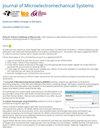优化 MEMS 匹配网络以提高 GHz 低功耗唤醒接收器的灵敏度
IF 3.1
3区 工程技术
Q2 ENGINEERING, ELECTRICAL & ELECTRONIC
引用次数: 0
摘要
本文详细研究了工作在 GHz 频段的低功耗唤醒接收器(WuRX)的微机电系统(MEMS)匹配网络(MN)设计。为了提高唤醒接收器(WuRX)的灵敏度,本文提出了微机电系统匹配网络(MN)和 CMOS 能量检测器(ED)之间的协同设计理论,并定量推导出在不同有效品质因数($Q_{eff}$)情况下的最佳电路拓扑和设计,此时 MEMS 谐振器被建模为有效电感($L_{eff}$)匹配元件。为了验证所提出的设计理论以及 MEMS MN(MMN)的高性能,我们制作并测试了 CMOS ED 芯片和各种不同尺寸的 FBAR 谐振器。测量结果表明,所演示的 MMN 的相对灵敏度增益($A_{sens}$)和电压增益($G_{v}$)分别达到了 8.6 dB 和 19.9 dB。所测得的 $A_{sens}$ 是所有已报道的在 GHz 频率下工作、具有类似 ED 输入电容的 MMN 中最高的。本文章由计算机程序翻译,如有差异,请以英文原文为准。
Optimization of MEMS Matching Network for the Sensitivity of GHz Low-Power Wake-Up Receivers
This work presents a detailed study on the design of microelectromechanical system (MEMS) matching networks (MN) for low-power wake-up receivers (WuRX) operating in GHz frequency bands. To enhance the WuRX sensitivity, a co-design theory between the MN and CMOS energy detector (ED) is proposed and derived quantitatively to give the optimal circuit topology and design under different scenarios of effective quality factor (
$Q_{eff}$
), when the MEMS resonator is modeled as an effective inductive (
$L_{eff}$
) matching element. To verify the proposed design theory as well as the high performance of MEMS MN (MMN), CMOS ED chips and various FBAR resonators of different sizes were fabricated and tested. Measurement results show that the demonstrated MMN achieves relative sensitivity gain (
$A_{sens}$
) and voltage gain (
$G_{v}$
) of 8.6 dB and 19.9 dB, respectively. The measured
$A_{sens}$
is the highest among all reported MMNs with similar ED input capacitance operating at GHz frequencies.[2024-0090]
求助全文
通过发布文献求助,成功后即可免费获取论文全文。
去求助
来源期刊

Journal of Microelectromechanical Systems
工程技术-工程:电子与电气
CiteScore
6.20
自引率
7.40%
发文量
115
审稿时长
7.5 months
期刊介绍:
The topics of interest include, but are not limited to: devices ranging in size from microns to millimeters, IC-compatible fabrication techniques, other fabrication techniques, measurement of micro phenomena, theoretical results, new materials and designs, micro actuators, micro robots, micro batteries, bearings, wear, reliability, electrical interconnections, micro telemanipulation, and standards appropriate to MEMS. Application examples and application oriented devices in fluidics, optics, bio-medical engineering, etc., are also of central interest.
 求助内容:
求助内容: 应助结果提醒方式:
应助结果提醒方式:


